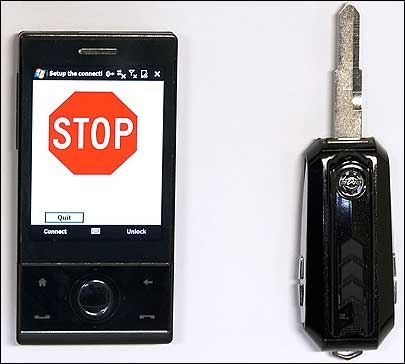Jan 16, 2009A University of Utah professor and graduate have developed a solution that, via passive RFID or active Bluetooth technology, can effectively prevent drivers from texting or speaking on their cell phones while operating cars. The university has obtained provisional patents, and the solution has been licensed to Accendo, a Keysville, Utah, company that provides early-stage business consulting and seed funding.
The solution, known as Key2SafeDriving, was invented by Xuesong Zhou, an assistant professor with the university's department of civil and environmental engineering, and Wally Curry, a University of Utah graduate now practicing medicine in Hays, Kan., and includes a hard plastic shell that encloses a car key. When the key protrudes from the shell (by either manually sliding it out or pushing a button that pops it out), the Bluetooth transmitter is switched on and begins communicating with the cell phone's Bluetooth radio—or, in the case of RFID, the RFID inlay embedded in the key's plastic head is exposed, thereby enabling the interrogator built into the cell phone to read the inlay's unique identifier.

Here's how Key2SafeDriving will be designed to work: To start the car, a driver will either slide the key out of its shell or push a button to release it. This, in turn, will expose the RFID chip to the cell phone's RFID reader, or activate the Bluetooth communications, either of which will wirelessly communicate a unique ID number to the driver's cell phone (which must have either RFID or Bluetooth capability). If the cell phone receives such a signal, it enters "driving mode" and shows a stop sign on the phone's display screen.
When in driving mode, the phone cannot be used in any manner. The solution will include the capability to override this mode without sliding the key back into the enclosure if 911, or other numbers preset in the phone, are called or received. When those numbers either call in or are called, the phone switches out of driving mode, and when the user hangs up, the phone automatically reverts back to driving mode once more.
While the phone is in driving mode, incoming calls and text messages will be automatically answered with a message indicating, "I am driving now. I will call you later when I arrive at the destination safely." Once the engine is turned off, the driver can then slide the key back into the Key2SafeDriving's plastic shell, which deactivates the Bluetooth transmitter or blocks the RF signal—which the cell phone interprets as "car stopped." The phone is then returned to normal communication mode.
Zhou says that Curry—who came up with the idea to prevent teens from talking on their cell phones while driving—called him in early 2008 to discuss the concept. The two originally considered using a GPS system that could detect a moving cell phone and disable it when the phone moved at driving speeds. But GPS cannot distinguish if the cell phone's user is the driver or a passenger in a moving car, bus or train, Zhou says. Prior to joining the University of Utah, Zhou worked as a traffic data architect and senior software engineer at Dash Navigation Inc., designing and developing real-time traffic estimation and prediction algorithms for Internet-connected GPS navigation systems. Drawing on this experience, Zhou suggested using RFID, and during a phone conversation last summer, the two men got the idea to add the key to the solution.
Ronn Hartman, a managing partner with Accendo, says Key2SafeDriving is currently in the prototype stage. Several companies that manage fleets of vehicles have signed up to test the solution, possibly within 30 days. The prototype utilized in these upcoming tests will not use a key equipped with either Bluetooth or RFID; instead, drivers will manually push a button that will switch the phones to driving mode so they can't be used. "We just want to start collecting data, and tracking on that," Hartman explains.
The original intention was to market the solution to cell phone service providers, which would include the solution in their service plans. "But now," Hartman says, "based on the overwhelming response we've gotten, we've decided to take it directly to market, to fleet companies, consumers and others." He says he has also spoken with insurance companies regarding the possibility of leveraging Key2SafeDriving data, which documents how often a cell phone was set in driving mode, versus override mode.
By capturing the number of times the phone was in driving mode, insurers would have proof that drivers were correctly using the Key2SafeDriving solution. That data could be compiled into a "safety score" and sent monthly to insurance companies, which could then provide discounts to motorists who had good scores (that is, scores that show the drivers often had their phones operating in driving mode).
The plan, Zhou says, is to have a commercial solution ready in approximately six months. "The first product will probably be Bluetooth," he notes, "with RFID following soon after. RFID is really the way to go."


